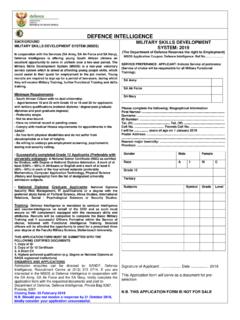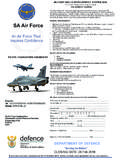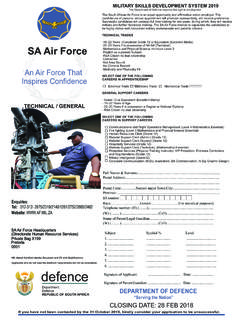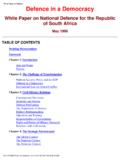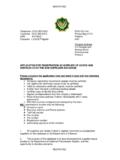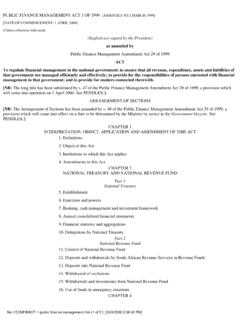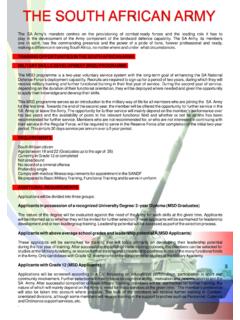Transcription of South African Defence Review Table of contents
1 South African Defence Review Table of contentsSouth African Defence Review Table OF CONTENTSC hapter 1: Introduction Aim and FocusProcess of Conducting the Defence ReviewScope of the Defence ReviewLogic of the Defence ReviewKey Concepts Underpinning the Defence Review Chapter 2 : Defence Posture and Doctrine Policy FrameworkDeterrence SANDF DoctrineImplications for Force Design Chapter 3 : Self- Defence and the Peace-Time Force IntroductionTasks The "Core Force" ApproachDefence ContingenciesCharacteristics of the Peace-Time ForceCapabilities Required by the Peace-Time Force Chapter 4 : Regional Security Co-operation Policy FrameworkPeace Support OperationsPostureRegional Structures Chapter 5 : International Peace Support Operations Policy FrameworkTypes of Peace Support OperationsAuthority and Decision MakingDepartmental and Operational ConsiderationsTrainingForce Design Chapter 6 : Co-operation with the South African Police Service Policy Frameworkfile:///D|/backup/ Defence %20 (1 of 4)2006/09/26 11:04:45 AMSouth African Defence Review Table of contentsStrategic ApproachCost-Effective Utilisation of ResourcesForce Design and Force Levels Chapter 7 : Non-Military Tasks Policy FrameworkDescription of Non-Military Tasks Chapter 8.
2 Force Design OptionsIntroductionTasksForce Design LogicForce Design OptionsStatus of Force DesignOption 1: Recommended Growth-Core Force DesignOption 2: Department of Defence Long-Term Vision Force DesignOption 3: Lower Level Demonstration OptionOption 4: Defensive Operational Concept Force DesignConclusionSANDF Force Design OptionsChapter 9 : Force Structure The Transformation of the Department of DefenceCivil Control over the MilitaryOrganisational TransformationSystems ApproachJointnessOrganisational StructureAnnual Budget RequiredAppendix A : Proposed Type Formations and Units Chapter 10 : Human ResourcesPolicy FrameworkComposition of the DoDStaffing the SANDFF uture Size, Composition and Management of the DoDRepresentivityAffirmative Action, Equal Opportunity and Management of DiversityEducation and TrainingLabour and Service RelationsMedical, Psycological and Social ServicesSport and Recreationfile:///D|/backup/ Defence %20 (2 of 4)2006/09/26 11:04:45 AMSouth African Defence Review Table of contentsOther Related Military Organisations Chapter 11.
3 The Part-Time ComponentIntroductionAim and Scope of This ChapterHistory of the PTCC onstitutional and Policy FrameworkThe "One Force Concept"National AssetVisionRoles of the PTCA Balanced Command StructureDecision-Making on PTC MattersAspects of Command and ControlTransformationVoluntary Military SystemCommunity SupportYouthStructural TransformationTerritorial UnitsResource AllocationService Conditions and BenefitsTrainingEmployer/Organised Labour SupportMarketingInternational AffiliationsMilitary Veterans Conclusion Chapter 12 : Land and EnvironmentOverview of Department of Defence LandDoD Land Use RequirementsDisposal of DoD Land and FacilitiesLand Claims and RestitutionEnvironmental ManagementConclusion Chapter 13 : The Acquisition Management ProcessIntroductionDefining the Defence IndustryDepartment of Defence RequirementsDoD Acquisition Policy file:///D|/backup/ Defence %20 (3 of 4)2006/09/26 11:04:45 AMSouth African Defence Review Table of contentsDefence Technology Development PolicySocial Responsibility of the IndustryArms TradeAppendix A : National Policy Issues Chapter 14 : Defence Legal EnvironmentChapter 15.
4 ConclusionThe Defence Review as a Policy ProcessThe Defence Review as a Model for Civil-Military RelationsThe Medium-Term Expenditure FrameworkFuture Defence Policy Initiatives Glossary of Military Ranks with Corresponding Civilian AppointmentsNote on Terminology The term Ministry of Defence (MoD) refers to the offices of the Minister and Deputy Minister of Defence and their respective staffs. The term Department of Defence (DoD) refers to the offices of the Secretary for Defence , the Chief of the South Africa National Defence Force (C SANDF), the Chiefs of the Corporate Divisions and their respective :///D|/backup/ Defence %20 (4 of 4)2006/09/26 11:04:45 AMCHAPTER ONECHAPTER ONE INTRODUCTION AIM AND FOCUS OF THE Defence Review 1.
5 In May 1996 the Minister of Defence presented to Parliament the White Paper on National Defence for the Republic of South Africa. Parliament approved the document, with strong support expressed by all political parties. 2. The overarching theme of the White Paper is the transformation of Defence policy and the South African National Defence Force (SANDF) in the light of the momentous political and strategic developments which have occurred at national, regional and international levels following the demise of the Cold War and the ending of apartheid. 3. At national level these developments include the establishment of a democratic government; the introduction of the Reconstruction and Development Programme (RDP) to address poverty and socio-economic inequality; the policy of national unity and reconciliation; and the adoption of a new Constitution which outlaws discrimination, enshrines fundamental human rights and lays the basis for democratic civil-military relations.
6 4. After two and a half decades of isolation, South Africa has been welcomed back into the international community and has joined a host of important regional and international bodies. South Africa now engages in Defence co-operation with a number of countries and participates in regional security arrangements under the auspices of the Southern African Development Community (SADC). 5. In the light of these developments and the integration of the former statutory and non-statutory forces, the challenge of transformation is substantial and complex. The White Paper addresses this challenge at the level of broad policy. It establishes a policy framework and the main principles of Defence in our new democracy.
7 6. The White Paper also provides for a Defence Review , the aim of which is to elaborate on this policy framework through comprehensive long-range planning on such matters as posture, doctrine, force design, force levels, logistic support, armaments, equipment, human resources and funding. 7. More specifically, the White Paper provides that the Review will encompass the following: It will present options with respect to the size, roles and structure of the SANDF. file:///D|/backup/ Defence %20 (1 of 8)2006/09/26 11:04:46 AMCHAPTER It will address the implications of the core force approach, described in Chapter 5 of the White Paper, for the size, doctrine, posture, weaponry, equipment and other features of the SANDF.
8 It will address the strategic and technical implications of the constitutional provision that the SANDF "shall be primarily defensive in the exercise or performance of its powers and functions". It will deal with the implications of the principles of " Defence in a democracy", described in Chapter 2 of the White Paper, for the orientation of the SANDF. It will present, for the consideration of Parliament and the public, detailed and well-motivated budgetary forecasts and proposals; specific policies regarding the provisioning of logistic resources; and the identification of appropriate technology to optimise the cost-effectiveness of the core force. It will deal with the size and structure of the Part-Time Component (PTC).
9 It will include an examination of prevailing conditions in the SANDF with the view to rationalising current spending, eliminating waste and unnecessary duplication, and determining the most cost-effective means of managing human and material resources. It will provide details on the rationalisation, redesign and right-sizing of the SANDF given the absence of a foreseeable conventional military threat. In the context of demobilisation and rationalisation, it will outline a formula and guidelines for ensuring that the former statutory and non-statutory forces are equitably represented in the OF CONDUCTING THE Defence Review 8. The drafting of the Defence Review was the responsibility of a Working Group appointed by the Minister of Defence and co-ordinated by the Secretary for Defence .
10 The Working Group established specialist sub-committees on Defence posture, functions and force design; human resource issues; the PTC; the arms industry; legal issues; and land and the environment. 9. The Working Group and its sub-committees comprised members of Parliament, the Defence Secretariat, the regular and part-time components of the SANDF, Armscor and the Defence industry, the academic community, and non-governmental organisations. 10. In the interests of achieving a national consensus on Defence matters, the Minister decided at the file:///D|/backup/ Defence %20 (2 of 8)2006/09/26 11:04:46 AMCHAPTER ONEoutset that the Review should be subject to a process of consultation with Defence stakeholders and interest groups.
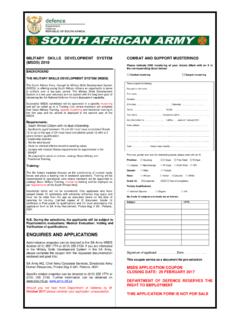
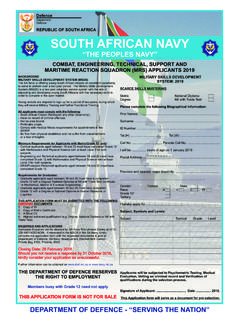
![[a42y2002]DEFENCE ACT 42 OF 2002](/cache/preview/4/8/f/0/8/f/6/c/thumb-48f08f6ca7f1fb0dc9c37b3eb3dc705b.jpg)
